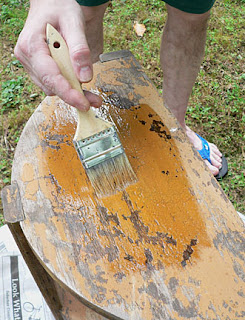 QUESTION: My grandmother had a cabinet in her kitchen which she called a “Hoosier.” She told me her mother left it to her and now I have it in my kitchen. What can you tell me about it?
QUESTION: My grandmother had a cabinet in her kitchen which she called a “Hoosier.” She told me her mother left it to her and now I have it in my kitchen. What can you tell me about it?ANSWER: The modern kitchen with its microwave, glass-topped stove, side-by-side refrigerator, and granite countertops is a far cry from your great-grandma’s kitchen. The most modern thing in her kitchen was her Hoosier, an all-in-one preparation and storage unit that brought her convenience and practicality.
Named after the Hoosier Manufacturing Co. of New Castle, Indiana, the Hoosier cabinet was to become one of the most popular pieces of furniture to hit the American market. Though there were other companies in Indiana that made them, Hoosier Manufacturing built over four million of these special cabinets between 1900 and 1940. Until 1920, the company made and finished their new all-in-one cabinet in natural oak, but as the third decade of the 20th century progressed, they began to offer Hooisers with white enamel-lined drawers. Because of the bright white of the enamel, people called them “White Beauties.”
When the Hoosier first appeared, American homes didn’t have built-in storage cabinets. Soon housewives demanded something in which they could store their baking supplies and equipment, as well as give them an additional work surface. The company quickly adapted the 19th-century baker’s cabinet, a piece of furniture they were already making, to fit the needs of the modern housewife. These existing cabinets featured a work surface to roll out and knead dough, a few cabinets above, and “possum belly” drawers below to hold flour and sugar. Manufacturers of these baker’s cabinets made the drawers from tin to protect their contents from rodents. At first, they made the work surface of wood, then later employed zinc, aluminum, and porcelain enamel. They attached casters to the legs, both for ease of moving and to keep ants out of the cabinet.
By rearranging the parts of the baker’s cabinet, Hoosier Manufacturing came up with a well-organized, compact unit which answered the housewife’s needs for storage and working space. The company added to these cabinets many improvements, including flour sifters, bread drawers lined with enamel, cutting boards, and an assortment of storage containers, to help the homemaker.
The typical Hoosier cabinet had three sections—a bottom section, featuring one large compartment with a slide-out shelf and several drawers to one side, a top portion only half as deep with several smaller compartments with doors, with or without windows, and a large lower compartment with a roll-top door that could be closed to hide various tools and equipment. Hoosier joined the top and bottom of the cabinet using a pair of metal channels which served as the guide for a sliding work surface, which usually had a pair of shallow drawers attached to its underside. The cabinet, with its work surface retracted, was normally about two feet deep— double that when pulled out—while the cabinet stood nearly six feet high.
A distinctive feature of the Hoosier cabinet was its accessories. Most came equipped with a variety of racks and other hardware to hold and organize spices and various staples. Some came with a hand coffee grinder and a combination flour-bin/sifter, a tin hopper that a housewife could use without having to remove it from the cabinet. Some contained a similar bin for sugar.
To hold a variety of spices and other staples, Hoosiers came equipped with special glass jars, manufactured by the Sneath Glass Company, to fit the cabinet and its racks. Original sets of Hoosier glassware consisted of coffee and tea canisters, a salt box, and four to eight spice jars. Some manufacturers also included a cracker or cookie jar. Some Hoosiers had elastic straps attached on the inside of their doors behind which housewives could place cards with such information as measurement conversions, sample menus, and household tips.
Manufacturers marked their cabinets with an identifying label which was often engraved or stamped onto metal, then screwed onto the front of the cabinet. Some glued paper labels on the back of the cabinet. Both types often disappeared as a result of refinishing.
Though Hoosier cabinets remained popular into the 1930s, they began to fall into disuse as soon as home builders equipped new kitchens with built-in cabinets and other appliances. Today, Hoosiers, dating from 1900-1910, sell on eBay for $500-$2,300. Later models sell for as little as $200.








































